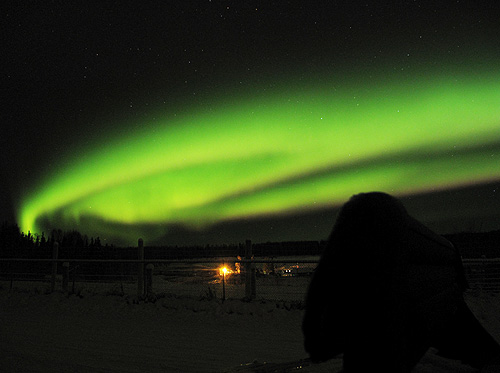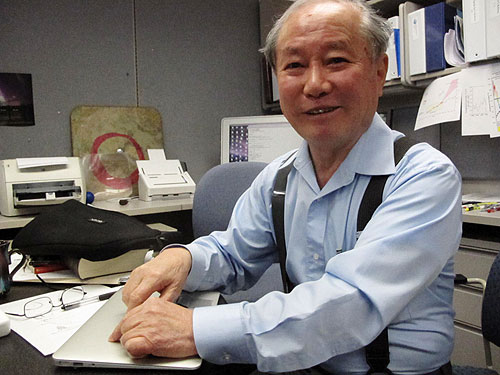
After a lifetime of study, aurora still a mysteryBy NED ROZELL
March 06, 2013
The man who came up with that name half a century ago has, with a former student he once mentored, come up with a new theory on the location of heavenly energy for these auroras.
Nothern aurora at onset of a substorm
During much of his six decades in the far north, he has pondered the complicated mechanisms that trigger the aurora. But there was a 20-year gap in Akasofu’s academic pursuits when he served first as director of the Geophysical Institute and then the International Arctic Research Center, both at UAF. He retired from high-level administrative work in 2007, and now spends fewer hours at the office. Now that he has free moments, Akasofu has, with some controversy, dug in to study the natural component of climate change, pointing out that the world should be getting warmer as it recovers from the Little Ice Age, which ended in the 1800s. He has also returned to his first love, the aurora. Akasofu and the man who was his first post-doctoral student — Tony Lui of Johns Hopkins University — have come up with an idea that’s different from a foundational belief of many who study space physics. That is not unusual for the 83-year-old contrarian.
Syun-Ichi Akasofu in his office.
Before pondering what he believes is evidence for the new idea about substorms, here’s an oversimplified view of how one works: Our sun, that burning ball of hydrogen gas, blasts a constant tsunami of gases over marble Earth. This solar wind flows over and behind Earth like a stream rushes around a boulder. Scientists came up with the name “magnetosphere” for the windsock-shaped flow around the planet. In the tail of this magnetosphere, way downstream from Earth, is where aurora researchers have long theorized that solar energy is changed into substorm energy, which then explodes Earthward by the process scientists call “magnetic reconnection.” Akasofu always thought the magnetic reconnection theory was not applicable to the aurora. Based on his study of the aurora and satellite observations, he figures that there is not enough energy in the tail. Tony Lui, who studies at the Applied Physics Laboratory at Johns Hopkins University, recently noticed a satellite observation that supports he and Akasofu’s hunch. They think the sun’s hot breath is stretching Earth’s magnetic field lines like a kid pulling back on a slingshot. When the field lines can no longer hold the stretching, they snap back toward the planet. In the process, electrons are separated and stream into Earth’s upper atmosphere. Those electrons bang into atoms of oxygen, which explode into swirling auroral substorms. Also evident to the pair is that this magical, substorm-causing process may occur about half as far from Earth than scientists have thought. This news might not change your appreciation for aquamarine lights detonating in a cold, clear sky, but a few space physicists will debate it with passion. Having released the idea, Akasofu is content to let others bat it around. In a career entering its sixth decade in which his own theories have been both embraced and disproven, Akasofu wonders if we will ever fully understand the aurora. One of his favorite quotes regarding the mystery of it all is from Charles Hall, an arctic explorer of the 19th century, who, pondering lights in the sky, wrote in 1864: “Who but God can conceive such infinite scenes of glory?”
Since the late 1970s, the University of Alaska Fairbanks' Geophysical Institute has provided this column free in cooperation with the UAF research community. E-mail your news &
photos to editor@sitnews.us
|
||

